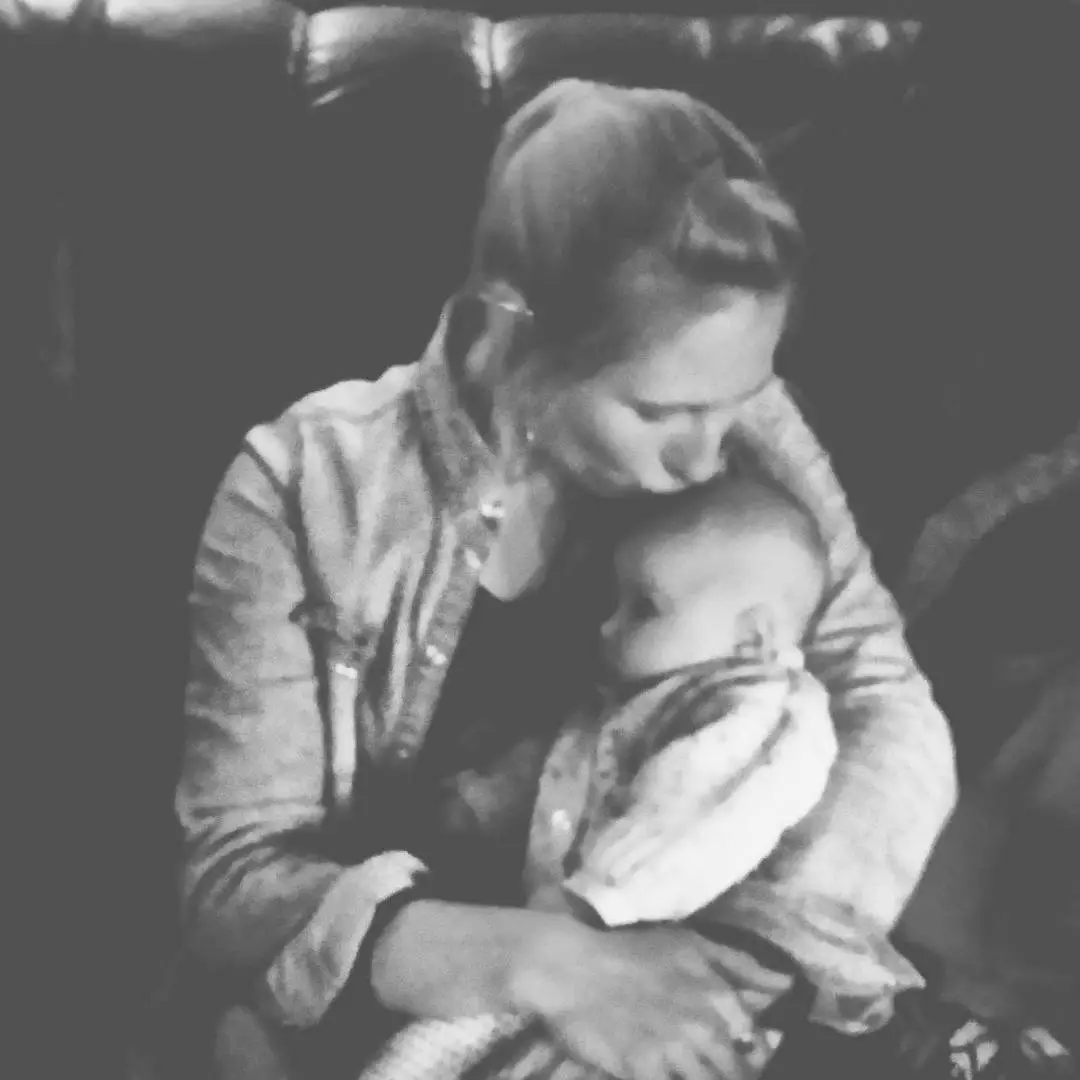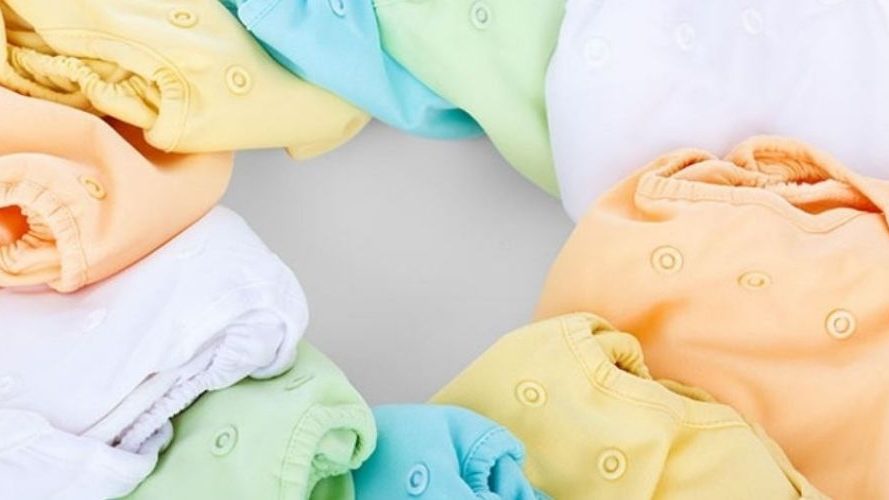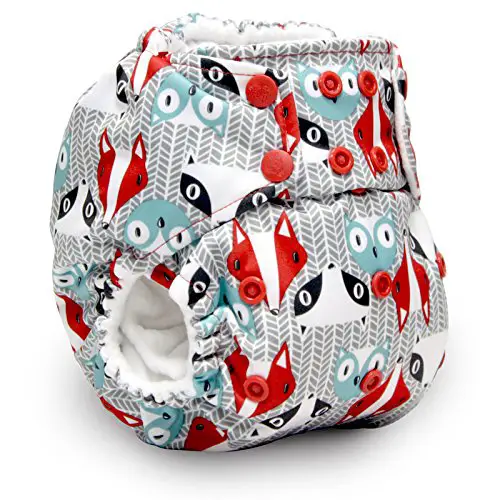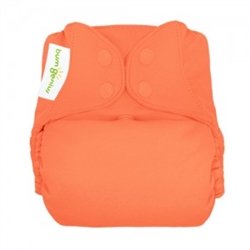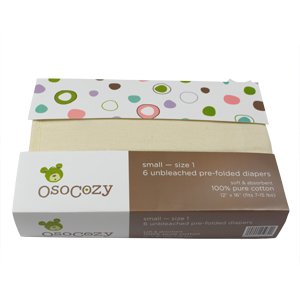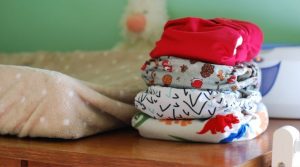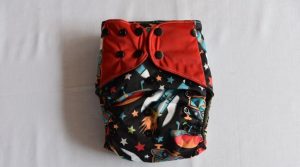Thinking of ditching disposables and turning to the cloth diapering way of life?
It’s no secret that, while there are days when disposable diapers seem like the best thing in the world, they are certainly not the best thing for the world. They end up in landfills (unable to biodegrade) by the billions each year.
Turning to cloth diapers is certainly a significant way to lessen your carbon footprint. And it’s easier to do these days as big bundles of cloth and safety pins are now a thing of the past. Many brands are just as simple to use as disposable diapers and, with a little bit of know-how, keeping them fresh and clean is also a cinch.
As parents of two cloth-diapered babies, we’re big fans of this way of life, and many others agree. We’ve written this guide to give you the information you need to switch to cloth diapers, and also listed our favorite brands so you don’t have to clean up a ton of blowouts before finding that perfect match.
In this article:
The pros and cons of cloth diapers
If you are researching how to change over to cloth diapers, or even just trying to find out if it’s doable for your lifestyle, there is no shortage of things to ruminate over. So let’s dive right in, shall we?
Related: How to Use Cloth Diapers
The Pros
- Price – We estimate you’ll save at least $400 over the course of three years having switched to cloth diapers. That’s a good chunk of change saved, and even more so if you are planning another child. Then you’ll already have your diaper supply in stock and will only need to add products for cleaning and maintenance. So your savings will soar!
- Cloth is safer – Every parent worries about what they’re putting against their infants skin. When it comes to diapers, cloth is an all around safer alternative. You won’t have to worry about what is making those disposable diapers so absorbent (spoiler alert, it’s called Super Absorbent Polymer, and it’s even in most ‘green’ diapers). Cloth is just that, cloth. No chemicals. No unnatural fibres. Just cloth.
- Laundering – There’s no need to fret about washing your cloth diapers. Simply shake any solids into the toilet and store the soiled diaper in your diaper pail. When laundry day rolls around, put the diapers through two cycles with your detergent of choice and two rinse cycles to remove any remaining soap residue. Dry on hot, and you are good to go! Another option, especially if you live in a city, is to use a diaper service. They’ll pick up your infant’s unmentionables, wash them thoroughly and return them to you good as new. Be sure to consider the expense of using this service as, while convenient, it could add a few thousand dollars (over a three year period) to your baby budget.
Nothing in the world is perfect, and cloth diapers are no exception. Here are some drawbacks to making the switch.
The Cons
- Laundering – While you aren’t adding to a landfill, you are doing more laundry. That means using more water and electricity. As of yet, there is no study to clearly determine how much this offsets the green benefit.
- Convenience – You lose the convenience of being able to throw away a dirty diaper when you are on the go, and must always have a way to transport it back to your home base.
- Diaper Creams – You can’t just grab any old diaper rash cream when you need one. Some creams stain cloth diapers, so you’ll need to do some research before you head to the store.
Choosing the best cloth diapers
Here are some things you need to know about cloth diapers. People sometimes make them sound more complicated than they actually are. Instead, we go the other way to keep it super-simple, as modern cloth diapers can be hassle free with a bit of know-how.
Different types of cloth diapers
- Flats: Usually made of cotton, these are a single layer of cloth that you can fold in several ways
- Prefolds: You fasten this rectangular piece of cloth around your baby by folding and securing it with a safety pin or cloth diaper accessory called a snappi. You will also need a waterproof diaper cover.
- Fitted diapers: These are no-fold cloth diapers. They are typically made from hemp, fleece, bamboo, or cotton, and come with snaps or velcro for a secure fit. They also require a cover.
- Contour: A sort of cross between a pre-fold and a fitted diaper, these are hourglass shaped and need a fastener, like a safety pin or two, if there aren’t snaps or velcro built into the diaper. And don’t forget the cover if you go this route.
- Pocket diaper: These diapers have their own fastening system (usually snaps or tabs) with elastic bands around the legs and waist. They have two layers, the outer portion being waterproof while the inner is designed to stay dryer for your baby’s comfort. Before putting it on, you place an insert into the “pocket,” then you’re both off to the races.
- All-in-One: Much like a disposable diaper, this product has an inner layer for comfort, an absorbent layer, and a waterproof exterior. Although all-in-one cloth diapers are low maintenance, they can be bulkier to store than other picks.
- All-in-Two: This diaper also resembles a disposable diaper. An insert is placed into the diaper and, when soiled, you can swap it for a clean one without having to change the whole diaper. This makes them one of the easiest cloth diapers to travel with.
- Hybrid: Basically very similar to the All in Two, you can use a cloth or disposable insert depending on what you prefer. The flexible absorbency makes this cloth diaper one of the best for heavy wetters.
Inserts for added absorbency
You can buy inserts for some types of diapers separately, enabling you to customize how well the diaper absorbs. If, say, your baby is a heavy wetter, you’ll want an insert that’s going to really absorb moisture. Pay attention to the material type of absorbent inserts as their differing fabrics can serve different purposes. For example, bamboo is very absorbent, while hemp can hold a lot of liquid without adding bulk to the diaper. You will also see inserts made from cotton, microfiber and, more recently, Minky.
Liners
These are an optional accessory, but can make cleaning out that messy diaper far easier. They also protect your cloth diapers from creams that might leave stains and, most importantly, can help keep your infant’s skin drier. If you decide to add liners to your cloth-diapering regimen, you can choose either reusables or disposables.
Cloth diaper fabrics: know your options
Just like the rest of baby’s wardrobe, there are fabric options you can choose from when buying cloth diapers. Each has pros and cons worth noting, and learning more about these will help you make an educated pick.
Cotton
All natural and highly absorbent, cotton is quite forgiving when it comes to washing and care; however, not all cotton cloth diapers are the same. If you’re on the hunt for truly natural cotton diapers, be sure that the fabric is certified organic. This way you’ll know that it’s free from pesticides and is non-GMO.
Cotton makes some of the best cloth diapers for babies with exceptionally sensitive skin because it’s naturally hypoallergenic. Cotton diapers tend to be more durable, even after repeated washes, so will be replaced less often. Though they don’t offer moisture wicking, the fact that baby is able to feel the sensation of a wet diaper can help encourage earlier toilet training.
One important thing to know about organic cotton diapers is that, unlike other materials, which only require a couple of washes before being put into rotation, organic diapers may require up to eight washes in order to reach their maximum absorbency. This is because the natural oils present in organic cotton can act as a moisture repellent, preventing the diaper from being effective. Even when fully prepped, cotton diapers are less absorbent as their counterparts made from bamboo, fleece or hemp.
Wool
Another naturally-sourced fabric choice, wool, contains lanolin which is highly effective at moisture wicking. Being naturally antibacterial, it’s less likely that odors will become a problem, helping rash-prone babies to avoid those irritating microbes. Wool is typically used to make diaper covers, rather than the diapers themselves, and are sometimes referred to as ‘woolies’ or ‘wool soakers.’ They’re breathable, soft, and mostly designed to fit easily under baby’s other clothes.
There are a few downsides to choosing wool you may want to consider. Wool soakers are often more expensive than synthetic alternatives, while washing them can sometimes prove complex. Those prioritizing eco-sustainability when making product choices might wish to avoid them, simply because much of industrial wool production places a high demand on land, water, and energy resources; while certain inhumane industry practices prevent wool from being considered truly vegan.
Hemp
Generally blended with other fabrics like cotton, hemp offers slow absorbency making it an ideal material for cloth diaper inserts and cores. When organically grown, hemp is a fiber that’s pesticide free. It’s also naturally hypoallergenic and antibacterial, and, therefore, one of the best cloth choices for avoiding rashes. Hemp is a very strong fiber, and when typically blended with cotton, it creates a thin yet highly absorbent, durable diaper that resists odor absorbency and washes easily.
There are few downsides to hemp diapers, yet they should still be noted. More costly than standard cotton cloth diapers, because they’re so absorbent, they also take longer to dry.
Bamboo
Cloth diapers made from bamboo fleece or bamboo viscose are softer to the touch, so can lend extra comfort in wear. They also have a higher absorbency than cotton so are more adept at preventing leaks. Natural antibacterial properties found in bamboo fiber also help repel odor and mitigate rash risk..
Although readily reaching for diapers which claim to be made from sustainably grown bamboo, it’s worth noting that turning the woody plants into the soft fabric used to produce these diapers can occasionally prove less gentle to the environment. Also, like other highly absorbent fabrics, it takes a bit longer to dry fully.
Other helpful cloth diaper accessories
Getting ready to make the switch to cloth diapers? Here are a few accessories that will help you with the process; some essential and others optional, but useful.
- A diaper cream that’s compatible: Diaper rash cream is an important part of baby’s product regimen, but, beware, some petroleum-based products can leave unsightly stains and, worse yet, cause cloth diapers to repel, rather than absorb, moisture. We suggest you stick to rash creams that are cloth-diaper compatible; with Aveeno, Burt’s Bees, Boudreaux’s, Honest Company, Palmer’s, and Shea Moisture all offering creams that work well.
- Diaper covers: If you choose a cloth diaper style like pre-folds, fitted diapers, or foldable diapers, a diaper cover worn over baby’s nappy and under their clothes will be necessary to keep them dry. Opting for a pocket diaper that use inserts typically means a diaper cover won’t be needed. As with diapers, you’ll need more than one of these on hand; we suggest 6 for a new baby, 4 for older babies, and 2 for a toddler.
- A good diaper bag: Though helpful whether using cloth or disposable diapers, the need to carry soiled diapers in a wet bag means parents choosing cloth diapers will require a spacious diaper bag with individual zippered compartments. This will offer handy on-the-go storage that your purse just can’t, and can separate (and contain) a wet bag with a messy nappy until you’re home and can properly clean it up.
- Wet bags: These handy gadgets are an essential for parents who live life on the go with cloth diapers. Since you won’t be tossing away baby’s dirty diaper, you’ll need a way to contain it until you get home. Wet bags have both moisture and scent-repellent interiors with closures that keep a dirty diaper tucked away.
- A diaper pail and liners: Unless you’re doing the laundry every single day, you’ll need a place to store your little one’s soiled nappies. After solid waste has been dumped into the toilet and flushed away, they should be placed into a diaper pail until it’s time to wash. Liners are technically optional, but keep things more sanitary and a bit easier for you — even a cloth flour sack can do the job, if you prefer to avoid plastics.
- Reusable wipes and a sprayer: If environmental consciousness factors into your choice to use cloth diapers, disposable wipes are a product you’ll probably want to leave behind as well. A soft, washable cloth and spray bottle of water are just as effective; look for a sprayer that creates a gentle mist rather than an intense stream.
- A dresser or storage tub: Parents, if you don’t already have some storage in baby’s changing area, be aware that cloth diapers will demand it. You’ll need a good stash on hand if you don’t want to do laundry daily, and two or three dozen cloth diapers can take up more than one dresser drawer easily. Finessing some storage space or investing in a cabinet, small dresser, or storage tub will help you stay organized and keep diapers sanitary.
Our top picks of the best cloth diapers
Best Hybrid
Our opinion
- Size limit: 6 – 35 lbs
- Material: Polyester, fleece
- Style: Hybrid
- Uses inserts: Washable or disposable
- Colors/patterns: Orange, yellow, green, blue, pink, black
In our opinion, these are the best cloth diapers. They were quick favorites in our home, and it seems that many other parents agree! They’re hybrid pocket-cloth diapers so, as with disposable diapers, the inner and outer part is all one piece. You just have to stuff the pocket with inserts that you can pull out and change when the diaper is wet.
Each diaper comes with two inserts, allowing parents to work with their baby’s absorbency needs. We found that by using both inserts at night time, we had no leaks with either of our babies – hurrah! And the inserts are made from super soft, microfibre fleece, meaning your wee ones’ bottom will enjoy some extra cozy comfort.
They are a one-size, adjustable diaper and fit most babies from newborn – 30 months (6 – 35 pounds). They come in a variety of styles and in packs of 1, 3 or 6.
What we love
- Because they’re one-size, there’s no need to upgrade as baby grows
- Soft microfiber can be removed and washed
- Highly absorbent inserts prevent nighttime leaks
Watch for
- The inner adjustment strap has a bit of a learning curve
Best for heavy wetters
Our opinion
- Size limit: 6 – 35 pounds
- Material: Waterproof Polyester and microchamois
- Style: Pocket diaper
- Uses inserts: Cloth
- Colors/patterns: More than 20
These diapers are really easy to work with, so they’re great if you are new to cloth diapering or have someone watching your child who is unfamiliar with cloth diapers.
They come with a snap closure system making it very easy to secure them to the correct size for your baby.
The two included inserts can be combined to create the Rumparooz signature 6r soaker system giving you 6 absorbency settings with the different combinations below:
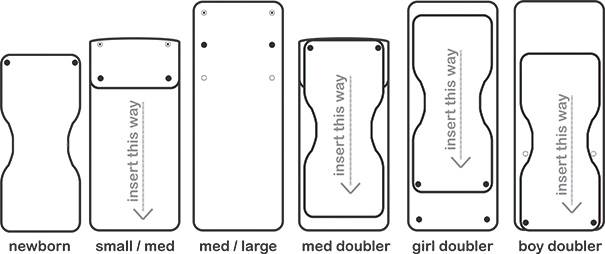
Unfortunately, once soiled, you do have to wash the entire diaper. On the plus side, they’re hypoallergenic, adorable, and fit babies from 6 to 35 lbs.
What we love
- Two inserts can be combined to create six different absorbency levels
- One-size design adjusts as baby grows
- More than 20 styles and colors available
Watch for
- Once the diaper has been soiled, the whole thing will need to be washed
Best all-in-one
Our opinion
- Size limit: 7 – 35 pounds
- Material: Laminated Polyester, Polyester, Nylon, Spandex
- Style: All-in-one diaper
- Uses inserts: Attached
- Colors/patterns: 10+
If you’re not into stuffing inserts into diaper pockets, here’s an all-in-one that we’ve gotten along with really well. Babies from 7 to 35 lbs will fit snuggly into this diaper, which has easy-to close-snaps, dries quickly after being cleaned, and comes in a variety of colors. While rather bulky, it offers absorbent protection for your baby, has an inner layer that wicks away moisture, and comfortable elastics on the leg openings. It’s also easy to use, so just right for those newcomers to the cloth diaper world.
What we love
- Inserts are semi-attached, saving you time
- The elastic around the leg openings is comfortable
- Inner layer features moisture wicking to prevent rashes
Watch for
- Can be somewhat bulky under clothes
Best pre-fold
Our opinion
- Size limit: 7 – 15 lbs
- Material: 100% Indian cotton
- Style: Prefolds
- Uses inserts: No
- Colors/patterns: Plain white
If you’re looking for ways to cloth diaper on a budget, this is a great place to start.
Naturally, because these diapers are prefolds, you will probably have to practice a few times to get them just right. You’ll also need to invest in a waterproof diaper cover.
However, they’re absorbent and comfortable, ideal for the bargain-shopping family or perfect for someone dipping their toe into the cloth diaper pool before making an expensive commitment.
What we love
- Indian cotton construction is durable, holding up to repeated washes and wears
- Comparable quality to prefolds provided by diaper services
- They rely on folding for absorbent layers, so are less expensive
Watch for
- These diapers will shrink about 5-10% after washing and drying — this is normal
- Prefolds require the use of diaper covers or plastic pants
Best cloth diapers for daycare
Our opinion
- Size limit: 6 – 35 pounds
- Material: Cotton, fleece
- Style: Pocket diapers
- Uses inserts: Yes
- Colors/patterns: 10+
Parents who are dubious about combining cloth diapering with a child in daycare, rejoice. The Bambino Mio Solo is the perfect all-in-one cloth diaper for their time away from home. The highly absorbent polyester core can stand up easily to heavy wetters and massive blowouts, and the stay-dry inner layer keeps pesky moisture from irritating your little one’s tender skin. This diaper also adjusts as baby grows, so won’t need replaced.
This stretchy, water-resistant diaper uses a system of pull-out tabs to separate the absorbent core from the outer diaper come washing time, allowing for a deeper clean and more efficient drying. We also love the design options here — with more than 20 adorable patterns to choose from.
What we love
- This diaper adjusts to baby’s size, so it won’t need to be replaced as they grow
- The absorbent core separates from the diaper for washing, so it gets cleaner and dries faster
- Because the core is so absorbent, it’s a good pick for a child in day care or a day on the town
Watch for
- It’s generously-sized, which can cause issues for very small babies
Best overnight
Our opinion
- Size limit: 6 – 35 pounds
- Material: Cotton, fleece
- Style: Pocket diapers
- Uses inserts: Yes
- Colors/patterns: 10+
Overnight leaks can mean a messy, cranky, rashy baby as well as an unsightly mess for parents to clean up, which means it’s best to choose cloth diapers that are highly absorbent when bedtime rolls around. The Ecoable Fitted Cloth Overnight Diaper uses a blend of cotton and naturally antibacterial hemp to create a fabric that will quickly soak up liquid and mitigate conditions that can lead to diaper rash.
Even heavy wetters can generally make it through the night dry with this diaper, though, as is always the case with fitted diapers, a waterproof cover is required; the cover also conceals the snaps which cover most of the outer diaper, allowing for a highly adjustable fit.
What we love
- Naturally antibacterial hemp is one of the best cloth picks for preventing diaper rash
- Lots of snaps mean the fit on this cloth diaper is very adjustable
- It’s absorbent enough to keep baby and crib dry overnight when used with a waterproof cover
Watch for
- A waterproof cover is required to prevent leaks with a fitted diaper
Best for newborns
Our opinion
- Size limit: Birth – 12 lbs
- Material: Polyester, Bamboo viscose
- Style: Pocket diapers
- Uses inserts: Washable/disposable
- Colors/patterns: Red, white, blue, yellow, orange, pale blue
Though it’s a noble idea to begin using cloth diapers as soon as baby arrives, a common problem new parents come across is that they simply don’t fit snugly enough to prevent leaks. ALVABABY Newborn Cloth Diapers tackle this problem easily, offering colorful, highly absorbent pocket diapers that use a snap system to assure a comfortable and secure closure.
These are suitable until baby is about 12 lbs, making them a great starter set for smaller infants, but parents should note that these are not one-size diapers, despite their appearance; once babies are heavier than 12 lbs, they’ll need something a bit bigger. Each diaper in the set comes with two newborn-size microfiber inserts, so absorbency can be adjusted as needed; the inserts that come with the set may be insufficient for heavy wetters, though these diapers work easily with other cloth and disposable inserts.
What we love
- They’re designed for newborns and small babies, so they’ll fit snugly enough
- Two inserts are included for each of the pocket diapers in the set
- The colors are bright, stylish, and cheerful
Watch for
- The inserts that come with this system may not be absorbent enough for heavy wetters
- Though they look like it in pictures, they’re not one-size diapers
Best for budget
Our opinion
- Size limit: 6 – 35 pounds
- Material: Cotton, fleece
- Style: Pocket diapers
- Uses inserts: Yes
- Colors/patterns: 10+
Parents considering cloth diapering as a money-saving alternative to disposables can sometimes be left with a bit of a price-tag shock when discovering how expensive some systems can be. Rest assured that more affordable options like Anmababy Cloth Diapers exist, and are just as effective at keeping your child dry when used properly.
These cute and colorful pocket cloth diapers come with highly absorbent microfiber inserts,which can also be used with other washable or disposable ones. They also use a snap system that allows the diaper to ‘size up’ with baby, removing any need for costly replacements as they grow. This set also comes with a convenient wet bag for storing a dirty diaper on-the-go, coming in handy on long outings.
What we love
- The budget-friendly price makes this set a great way to ease into cloth diapering
- Comes with microfiber inserts and can be used with your favorite washable or disposables
- The convenient wet bag makes diaper changing a breeze while on the go
Watch for
- Only one insert per diaper comes with this set, while heavy wetters sometimes require two
Best organic cloth diapers
Our opinion
- Size limit: 3 – 6 months, 6 – 12 months, 12 – 24 months
- Material: 100% organic Merino virgin wool
- Style: Diaper cover
- Uses inserts: No
- Colors/patterns: Off-white
If you’re using a cloth diaper system that doesn’t utilize inserts, a handy waterproof cover should be on your to-buy list. A breathable, single-knit pick like the Engel Organic Merino Diaper Cover is ideal, as it uses the soft, absorbent wool to catch leaks, and naturally-present emollient lanolin to wick moisture away from the skin.
This cover is low on bulk, making it easy to dress your little ones without them looking stuffed into their clothing. Downsides could be the need for more frequent changes, and that they shouldn’t be used during naps or overnight. Then, again, they’re ideal on those warm days when a full wool soaker under a jumpsuit is sure to lead to a fussy babe.
What we love
- Lanolin, which is naturally present in wool, keeps moisture away from the skin
- This cover is single-knit, breathable and not bulky under clothes
- No synthetic materials
Watch for
- They need to be changed more frequently than heavier wool soakers
CLOTH DIAPER FAQ: THE INFO YOU NEED
How many cloth diapers do I actually need to buy?
We’ll be honest with you — a lot of this answer depends on your willingness to do laundry, though your baby’s age is also relevant. Newborn babies go through the same approximate number of diapers per day whether disposable or cloth, which can mean between 12 and 18; the minimum number you’d need on hand when they’re small. As they progress through infancy, they’ll need fewer nappies each day, typically maxing out at 10. During toddler years, this will decrease even more.
So the decision of how many diapers to keep on hand is up to you. Most parents find that two to three dozen is suitable to ensure that baby has plenty of clean nappies and daily laundry isn’t needed.
How often does baby’s cloth diaper need changing?
Just as with disposable diapers, the best practice is to keep your baby clean and dry by changing them as soon as they’ve used their cloth diaper; this helps to prevent skin irritations like diaper rash. If you’re not sure whether or not your little one needs a change, give them a quick check about every two hours, which is about as frequently as changes are typically needed.
There’s no reason to disturb baby’s peaceful sleep to change their nappy, either. Start the day with a diaper change and they’ll be just fine.
Will cloth diapers keep baby dry overnight?
Getting baby to sleep through the night is high on the wish list of many parents, which means late-night wake ups caused by irritating wet nappies are on the no-fly list. Although extra precautions are required, cloth diapers are certainly capable of getting your little one through the night dry and comfortable, though a heavy wetter may need some extra reinforcement. If you’ve chosen a cloth diaper style other than a pocket diaper, the use of wool soakers or another waterproof cover can help to keep them cozy. If using inserts, doubling up is often the best bet; this will typically get even heavy wetters through the night without a problem.
Can I make my own cloth diapers?
If you’re handy with a sewing machine and like trying your hand at new crafts, you may want to consider DIY cloth diapers as a cost-effective option. There are lots of helpful tutorials and Youtube videos online that demonstrate how to make a cloth diaper from start to finish. Some even include suggestions about how to repurpose old clothes and textiles you have in storage, saving you even more money! There are also some no-sew options for craft-conscious moms who don’t have time for a big project.
How can I make it easier to travel with cloth diapers?
We’ll admit it — disposables certainly outshine cloth diapers for convenience during travel, as you can simply bag them up and toss them away! However, the long-term environmental impact of doing so is certainly worth considering, with a bit of extra effort making travel with cloth diapers just as easy (while reducing your carbon footprint).
Wet bags are essential when you’re out with your cloth-diapered baby, as they make cleaning and storing a dirty nappy a simple process. A wet bag is a washable, moisture-and-odor-repellent sack that fastens shut, containing your little one’s soiled diaper till it can be placed in your diaper pail. After flushing away solid waste, simply tuck the diaper into the bag. Of course, finding a discreet compartment to store the bag presents a new challenge, which brings us to diaper bags.
Diaper bags are one of those parent-101 essential items that can make life worlds easier for many parents, being especially important when using cloth diapers, as they offer a sanitary spot for stashing used wet bags. They’re also roomy enough to store extra diapers, accessories, and other on-the-go stuff for your tot. Look for one that opens wide, enabling you to see what’s inside, and uses zippered compartments allowing you to organize and separate items.
It’s also worth considering which styles are easiest to change — we prefer a pocket diaper or hybrid for travel, but an all-in-one diaper can be bulky to carry.
How do I dispose of solid waste?
Simple! Just shake the diaper into the potty to eliminate solid waste, flushing it into the septic system, then toss it into the diaper pail until laundry time.
How do I wash cloth diapers?
Although you can wash your baby’s cloth diapers in a standard washing machine, your choices of detergent, water level, and temperature are important. We also recommend you think twice about washing them with other clothes. Here are some other common questions and practices to remember when using cloth diapers.
Do I need to wash new diapers before baby wears them?
Although new cloth diapers may be fully boxed or wrapped, as with other garments it’s wise to give them a good wash to get rid of any dirt or debris. Even more so with cloth diapers, as it also pulls natural oils out of fabric which can cause it to repel moisture rather than absorb it.
While most cloth diaper materials will be fully prepped for wear after two washes, materials like organic cotton hold a bit more natural oil and may need as many as eight washes before reaching their maximum absorbency.
What laundry detergent should I use to clean cloth diapers?
Although cloth diapers are an eco-friendly alternative to disposables, you may want to skip your usual green detergent when washing baby’s cloth diapers; not all options are as effective on biological waste, which can leave diapers visibly dirty or with unseen bacteria. Seventh Generation laundry soaps are a notable exception, while Purex, Arm and Hammer, and Gain are also effective choices. It’s always best to choose a fragrance and dye-free detergent, as this shields baby from unwanted allergens.
What washing and drying process should I follow?
Keeping things simple, let’s begin with the moment you remove baby’s soiled diaper.
- First, empty all solid waste into the potty and flush. A diaper sprayer can be used to saturate large stains and remove stubborn material; fully soaking the diaper with water before placing into the pail can help prevent stains from setting.
- Wash between 12 and 18 large-size cloth diapers per load. Fewer diapers may not get clean due to a lack of agitation in the washer barrel, while more may overcrowd. Use your machine’s highest water level to ensure a thorough cleaning. It’s best to wash diapers in warm water, using one of the detergents we’ve recommended.
- When the wash cycle is finished, you can either machine-dry your child’s diapers according to manufacturer instructions or hang them on the line. If you choose to use your dryer, skip the dryer sheets! They can leave an invisible, waxy coating on diapers that makes them repel moisture.
Our cloth diapers still smell bad after washing. What should we do?
If you’ve washed your cloth diapers repeatedly but find the smell of waste still lingers, the cause is bacterial buildup trapped in the cloth’s fibers. Try trading out your current washing routine for the one we’ve recommended above while switching detergents to a fragrance-free option that uses oxidizers in its formula.
If that yucky smell remains, it may be time to strip the diapers entirely — See below for a walkthrough.
How do I strip cloth diapers, and when is it necessary?
Stripping diapers isn’t something you should need to do often, but if you notice a persistent scent after washing, or cloth seems to be repelling moisture, stripping can often restore diapers to their original state.
There are special diaper stripping detergents available which are fairly effective, but we’ve found that one of the cheapest ways to do this with is old fashioned, multi-purpose blue Dawn dish soap and hot water.
- Fill your kitchen sink or bathtub with hot water.
- Add a tablespoon of blue Dawn, or 3 – 4 tbsp for a tub.
- Soak the diapers for about an hour, then thoroughly scrub both sides of each diaper with a laundry brush.
- Rinse them thoroughly, then launder them as normal.
Wrapping up
Hopefully, cloth diapering no longer seems as intimidating as it once did. It’s one of those lifestyle options that, like menstrual cups, can feel incredibly empowering once you do it (while working out better for the environment and saving you cash).
However, if still unsure about making the big switch, you don’t have to throw out all those traditional diapers all at once. By all means, purchase a few cloth diapers and see if they work for you. You might decide that regular diapers are simply a better fit (no pun intended!) or you may discover how easy cloth diapering really is and completely switch over. Then, of course, there’s the third option – there’s no rule that says you can’t alternate between cloth and traditional diapers.

